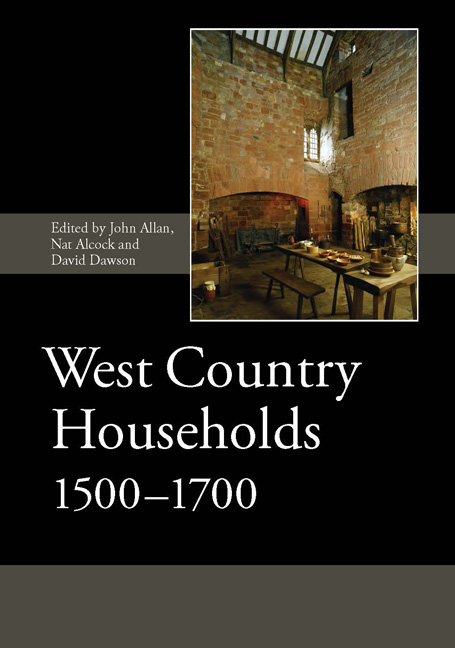Book contents
- Frontmatter
- Dedication
- Contents
- List of Illustrations
- List of Contributors
- List of Abbreviations
- Introduction
- I The Form and Development of West Country Houses
- II The Decoration of West Country Houses
- 5 The Polychrome-Decorated Plank-and-Muntin Screen at Marker's Cottage, Broadclyst, Devon, and its Context
- 6 The Interior Decoration of an Elizabethan Merchant's House: the Evidence from 41–2 High Street, Exeter
- 7 Sgraffito-Decorated and Painted Plaster on Devon Fireplaces
- 8 North Devon Relief-Decorated Ceramics in the Household
- 9 The Stained Hangings at Yarde Farm, Malborough, South Devon
- III The Material Culture of West Country Households
- Index of People and Places
- Index of Subjects
8 - North Devon Relief-Decorated Ceramics in the Household
from II - The Decoration of West Country Houses
Published online by Cambridge University Press: 05 May 2015
- Frontmatter
- Dedication
- Contents
- List of Illustrations
- List of Contributors
- List of Abbreviations
- Introduction
- I The Form and Development of West Country Houses
- II The Decoration of West Country Houses
- 5 The Polychrome-Decorated Plank-and-Muntin Screen at Marker's Cottage, Broadclyst, Devon, and its Context
- 6 The Interior Decoration of an Elizabethan Merchant's House: the Evidence from 41–2 High Street, Exeter
- 7 Sgraffito-Decorated and Painted Plaster on Devon Fireplaces
- 8 North Devon Relief-Decorated Ceramics in the Household
- 9 The Stained Hangings at Yarde Farm, Malborough, South Devon
- III The Material Culture of West Country Households
- Index of People and Places
- Index of Subjects
Summary
Relief-decorated earthenware tiles and hearth furniture formed a distinctive feature of the material culture of north Devon in the 17th and early 18th centuries; this paper reviews advances in their study. Recent finds show that, rather than being used largely in churches, the tiles were also in widespread domestic use. The paper assembles the new finds and discusses their distribution, the social status of the occupants and the way in which these ceramics were used in the household. The tiles were probably used in houses principally to line the jambs, reveals and backs of fireplaces, especially in first-floor chambers.
INTRODUCTION
In the 17th and early 18th centuries lead-glazed relief-decorated tiles were made in the north Devon potteries of Barnstaple, Bideford and Great Torrington. They are remarkable in a national context, since the production of decorative lead-glazed floor-tiles had ceased in most other parts of Britain at a much earlier date – in most areas by the mid-16th century. Prior to the recent past, such tiles were regarded principally as a form of church flooring, since the most numerous and best-known examples are those still to be seen in the churches of north Devon and the adjacent part of Cornwall. They were the subject of a classic paper by Laurence Keen in 1969, which established their date-range and production centres, documented their distribution in 34 churches and other sites, and illustrated 64 designs.
Alongside the production of relief-decorated tiles, the north Devon potters also made hearth furniture. This topic was also touched on by Keen, who recorded the sole example then known of a north Devon fireback and discussed three firedogs, but a much larger series of finds is now available for study. Three types of hearth furniture were decorated with the same stamps as the tiles: firedogs, spit supports and firebacks. These too are unusual in a national context: although individual examples of firebacks and spit supports have been reported elsewhere in Britain, all these classes of hearth furniture seem extremely rare outside north Devon.
- Type
- Chapter
- Information
- West Country Households, 1500–1700 , pp. 189 - 222Publisher: Boydell & BrewerPrint publication year: 2015



